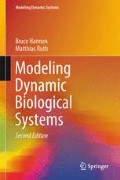Abstract
In this chapter we model an “ear” with a limited range of amplitudes of acoustic signals that it can detect.
A save-disabled version of STELLA and the computer models of this book are available at www.iseesystems.com/modelingdynamicbiologicalsystems.
Keywords
These keywords were added by machine and not by the authors. This process is experimental and the keywords may be updated as the learning algorithm improves.
The thirst for something other than what we have…to bring something new, even if it is worse, some emotion, some sorrow; when our sensibility, which happiness has silenced like an idle harp, wants to resonate under some hand, even a rough one, and even if it might be broken by it.
(Marcel Proust, Swann’s Way)
1 Basic Stochastic Resonance Model
In the previous chapter we modeled a “nose” that detects some odor. Let us model in this chapter an “ear” with a limited range of amplitudes of acoustic signals that it can detect. The threshold of audible amplitudes is arbitrarily set at 0.03. Let us specify a harmonic signal whose amplitude (0.01) is too low to be heard.
Additionally, there is noise in the system.
With the addition of noise the peak apparent amplitude to the ear is doubled, goes above the audio threshold and thus can be “heard”:
The “frequency” of the noise is the DT. In every DT the random level of the noise is changed. If the noise is not generated often enough, the signals become impossibly masked by the noise.
Our model of stochastic resonance is shown in Fig. 16.1. Try a DT of 0.001 and of 0.0625. The results are shown, respectively, in Figs. 16.2 and 16.3. Recognize how little of the harmonic signal can be detected if the frequency is too low.

Fig. 16.1

Fig. 16.2

Fig. 16.3
The human ear–brain smoothes over the fact that the peaks above the threshold are composed of several tightly spaced signals of noise plus signal. The same phenomenon is present in the eye-brain system. Imagine a set of leafless branches fidgeting in the wind, seen against a bright sky. Assume we are looking for a mammal moving through the branches. The movement of the branches is the “white” visual noise in this system. Our eye-brain system is extremely well equipped to filter out the dark shapes formed at random by the intersection of several branches, because this sort of shape does not persist. We easily see the mammal flitting though the branches. Adding leaves to these branches just makes the problem harder, but perhaps not impossible. So the eye-brain and ear–brain systems must learn to allow persistence of the input signal in order to appropriately average it and make decisions based on that average value. In the case of the combined audio signal, this quality of persistence allows one to compose the parts of this combine that exceed the audio threshold into a particular frequency. In the visual example, the persistence quality allows us to ignore those signals that are random and focus our attention on the more apparently purposeful motion.
Now that we have modeled a simple “nose” and an “ear,” let us turn to a more elaborate model of a four-chambered heart. This is the topic of the following chapter.
2 Stochastic Resonance Model Equations
-
COMBINED_SIGNAL = HARMONIC+NOISE
-
HARMONIC = SINWAVE(.01,.1)+.01
-
NOISE = RANDOM(0,.02)
Author information
Authors and Affiliations
Rights and permissions
Copyright information
© 2014 Springer International Publishing Switzerland
About this chapter
Cite this chapter
Hannon, B., Ruth, M. (2014). Stochastic Resonance. In: Modeling Dynamic Biological Systems. Modeling Dynamic Systems. Springer, Cham. https://doi.org/10.1007/978-3-319-05615-9_16
Download citation
DOI: https://doi.org/10.1007/978-3-319-05615-9_16
Published:
Publisher Name: Springer, Cham
Print ISBN: 978-3-319-05614-2
Online ISBN: 978-3-319-05615-9
eBook Packages: Biomedical and Life SciencesBiomedical and Life Sciences (R0)

